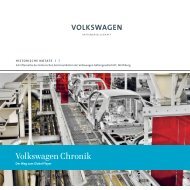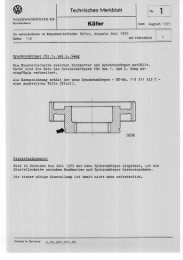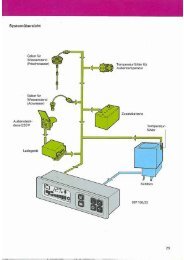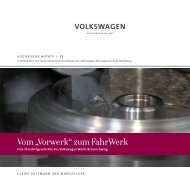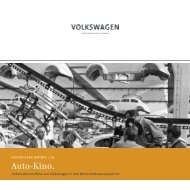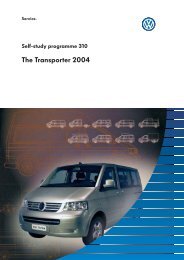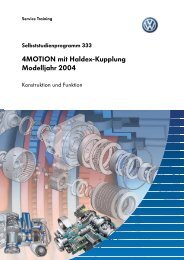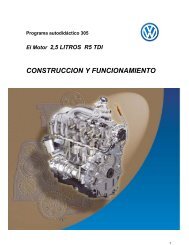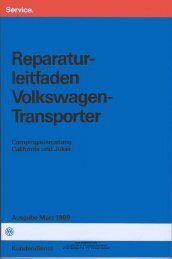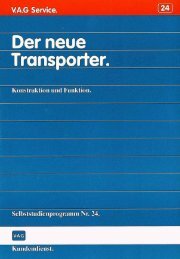HN 2: The British and their Works
HN 2: The British and their Works
HN 2: The British and their Works
Create successful ePaper yourself
Turn your PDF publications into a flip-book with our unique Google optimized e-Paper software.
visional compromise permitted sale of the surplus production<br />
to members of the <strong>British</strong> <strong>and</strong> American military government<br />
for 100 pounds per car. This discount price was intended to<br />
offset the fact that the Volkswagen could not be resold outside<br />
of Germany. But this veto ultimately fell victim to the plans<br />
for zonal amalgamation, because the Americans voted for unrestricted<br />
sales at a realistic price. Under American pressure it<br />
was decided in October 1946 to sell Volkswagens to the personnel<br />
of the Military governments, the military missions <strong>and</strong><br />
the United Nations at the full export price of 160 pounds. Resale<br />
was permitted, <strong>and</strong> in this way, indirectly, the first exports of the<br />
Volkswagen had been approved. 58<br />
<strong>The</strong> intended production increase to 2,500 vehicles per month<br />
gave rise to more reservations than assent, not only from the<br />
German factory management, as became apparent at the discussion<br />
on 21st June 1946. Even Richard Berryman, the officer<br />
responsible for production matters had his doubts, pointing to<br />
the poor condition of the machine tools, many of which needed<br />
overhauling. <strong>The</strong> available workforce, the food situation <strong>and</strong><br />
normal production problems would, according to Berryman,<br />
permit a maximum daily production of 100 vehicles over the<br />
next six months. Rudolf Brörmann advanced problems in toolmaking,<br />
machine repair <strong>and</strong> the general maintenance of the<br />
factory. In order to shift toolmaking <strong>and</strong> assembly from the<br />
ground floor <strong>and</strong> to make preparations for the winter, first of all<br />
the war damage to the buildings had to be repaired. He estimated<br />
that 2,000 extra workers would be required. In the view of<br />
the personnel management, even the 1,000-vehicle programme<br />
would cause serious problems due to the high turnover rate in<br />
the workforce. Neither the Military Government nor the labour<br />
offices were able to meet the requirements for labour, because<br />
the Volkswagenwerk did not enjoy sufficiently high priority.<br />
<strong>The</strong>re was still an acute housing shortage. <strong>The</strong>re was also a<br />
shortage of clothing, working overalls <strong>and</strong> footwear for the<br />
existing workforce <strong>and</strong> especially for new recruits. However,<br />
Major Hirst remained optimistic <strong>and</strong> issued the instruction to<br />
draw up plans for a medium-term production target of 2,500<br />
vehicles per month.<br />
A tricky topic for the German management came at the close of<br />
the discussion – in April 1946 the price of the saloon had been<br />
adjusted to reflect the increased production costs. Hirst’s comments<br />
were critical. As he said, the price of the car "could not<br />
start <strong>and</strong> end with the statistical cost accounting". 59 <strong>The</strong> days<br />
when you could sell a Volkswagen for 5,000 Reichsmark were<br />
long gone. In fact the order had already been received to make a<br />
drastic cut to Volkswagen prices. <strong>The</strong> Property Control officer<br />
McInnes therefore announced that as of July 1946 the saloon<br />
was to be sold for 4,000 Reichsmark. Since further instructions<br />
to reduce prices were to be expected, the unnecessary costs<br />
must be eliminated <strong>and</strong> the necessary costs "reduced to the bare<br />
minimum". It was, he said, in the interest of the company if it<br />
was managed on a financially sound <strong>and</strong> economical basis. 60<br />
McInnes had touched a nerve. In recent months the Board of<br />
Control had repeatedly called for a reduction of production<br />
costs. <strong>The</strong> factory management had set up various investigations<br />
– without success. In fact the overheads rose constantly in<br />
April, May <strong>and</strong> June 1946. <strong>The</strong> Property Control officer therefore<br />
26 27<br />
THE IMPROVED UPSWING



